Kaiser continues to sell its 1953 range until February 1954, when a simplified line-up is introduced as the company’s 1954 range.
Kaiser Carolina
A strip-down version of the Deluxe, this cheap but plain Carolina struggles to find its place on the market.
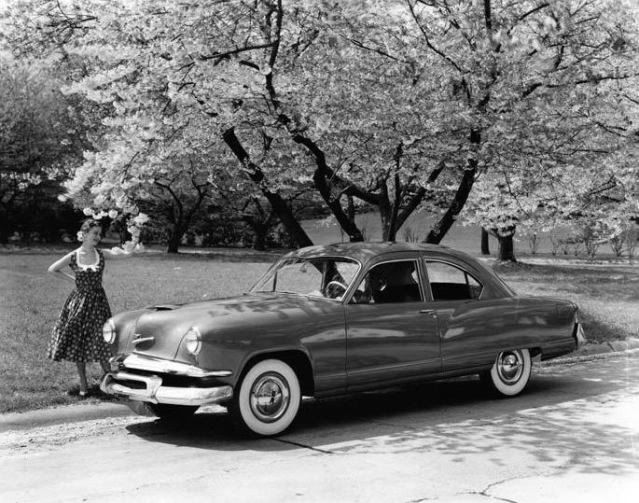
● Introduction: February 1950 for this generation of Kaiser models, March 1953 for the Carolina. Construction: body on separate chassis. Engine: water-cooled inline six, 3.7-litre, 118 hp, mounted at the front. Transmission: to the rear wheels through a three-speed manual gearbox. Three-speed automatic gearbox optional. Suspension: independent at the front, rigid axle at the rear. Brakes: hydraulic, to drums on all four wheels. Length: 536 cm. Top speed: 135 kph. Range: two-door club sedan, four-door sedan.
Kaiser Deluxe
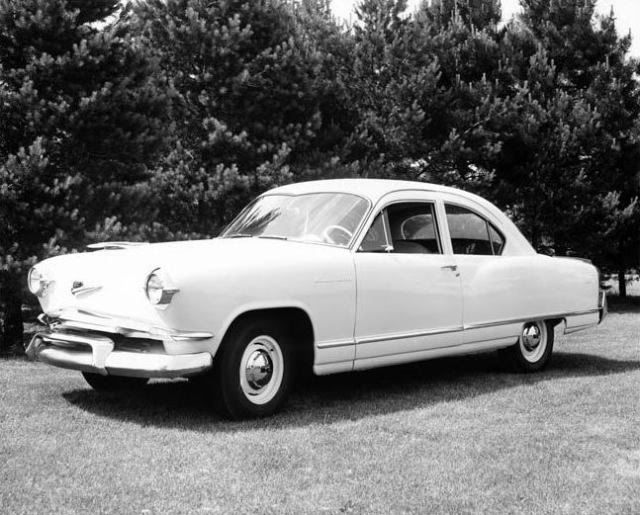
● Introduction: February 1950 for this generation of Kaiser models, March 1952 for the updated Deluxe. Construction: body on separate chassis. Engine: water-cooled inline six, 3.7-litre, 118 hp, mounted at the front. Transmission: to the rear wheels through a three-speed manual gearbox. Three-speed automatic gearbox optional. Suspension: independent at the front, rigid axle at the rear. Brakes: hydraulic, to drums on all four wheels. Length: 536 cm. Top speed: 135 kph. Range: two-door club sedan, four-door sedan, four-door “Traveler” utility sedan.
Kaiser Manhattan
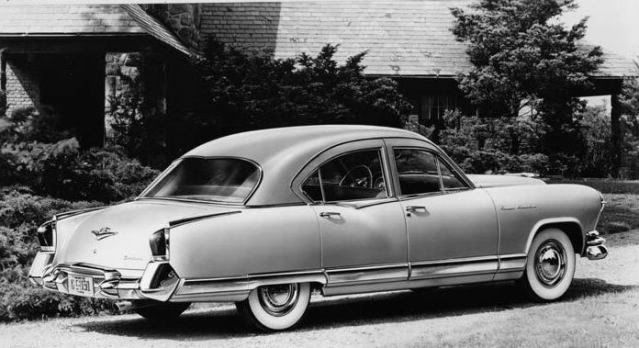
● Introduction: February 1950 for this generation of Kaiser models, March 1952 for the Manhattan. Construction: body on separate chassis. Engine: water-cooled inline six, 3.7-litre, 118 hp, mounted at the front. Transmission: to the rear wheels through a three-speed manual gearbox. Three-speed automatic gearbox optional. Suspension: independent at the front, rigid axle at the rear. Brakes: hydraulic, to drums on all four wheels. Length: 536 cm. Top speed: 135 kph. Range: two-door club sedan, four-door sedan, four-door “Traveler” utility sedan.
Kaiser Dragon
The extravagant Dragon virtually includes as standard equipment all possible options, among them a Hydra-Matic automatic transmission, air conditioning, radio, tinted glass and vinyl-covered roof.
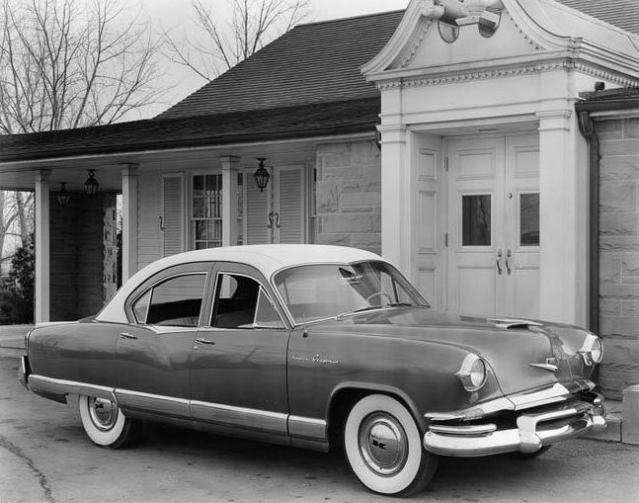
● Introduction: February 1950 for this generation of Kaiser models, October 1952 for the Dragon. Construction: body on separate chassis. Engine: water-cooled inline six, 3.7-litre, 118 hp, mounted at the front. Transmission: to the rear wheels through a three-speed automatic gearbox. Suspension: independent at the front, rigid axle at the rear. Brakes: hydraulic, to drums on all four wheels. Length: 536 cm. Top speed: 135 kph. Range: four-door sedan.
1954 models, replacing the extended 1953 range:
It is not before February 1954 that Kaiser unveils its models for the year. They feature a rather simple but extremely elegant front end, with a wide concave grille flanked by headlights already seen elsewhere - Kaiser’s designers apparently got their inspiration from the Buick XP-300’s headlights’ bezels, which they were fond of. A new wraparound backlight is fitted at the rear - confusingly, a few thousands of unsold 1953 cars are re-equipped with the new grille, headlights and rear lights, but retain their old type rear window… Under this new guise, the Kaiser is more elegant than ever. Alas, production lasts only until June 1954, after which the plant is converted for the production of Willys vehicles.
Kaiser Special

● Introduction: February 1950 for this generation of Kaiser models, February 1954 for the Special. Construction: body on separate chassis. Engine: water-cooled inline six, 3.7-litre, 118 hp, mounted at the front. Transmission: to the rear wheels through a three-speed manual gearbox. Three-speed automatic gearbox optional. Suspension: independent at the front, rigid axle at the rear. Brakes: hydraulic, to drums on all four wheels. Servo optional. Length: 536 cm. Top speed: 135 kph. Range: two-door club sedan, four-door sedan.
Kaiser Manhattan
Henry J. Kaiser having opted to spend its limited budget in cosmetic improvements rather than invest it in the construction of a V-8 engine, though such a block has been designed by his engineers, his cars seriously lack power as a race is on for ever higher outputs. A stopgap solution, a compressor is now fitted to the old Continental six powering the Manhattan, boosting it to a slightly more acceptable figure and allowing it to offer “power on demand”, as Kaiser’s advertisement people put it.
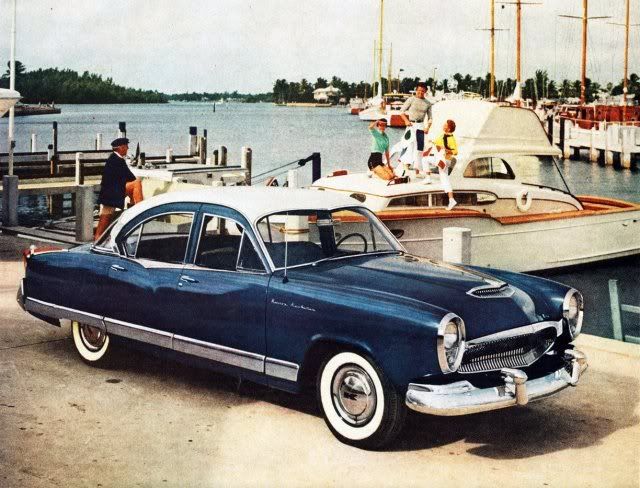
● Introduction: February 1950 for this generation of Kaiser models, March 1952 for the Manhattan. Construction: body on separate chassis. Engine: water-cooled supercharged inline six, 3.7-litre, 140 hp, mounted at the front. Transmission: to the rear wheels through a three-speed manual gearbox. Three-speed automatic gearbox optional. Suspension: independent at the front, rigid axle at the rear. Brakes: hydraulic, to drums on all four wheels. Servo optional. Length: 536 cm. Top speed: 145 kph. Range: two-door club sedan, four-door sedan.
Any mistake you’ve just spotted? A detail to add? A suggestion? Don’t hesitate to leave a comment!
Click to jump to another model year of the same car: 1950 – 1951 – 1952 – 1953 – 1954 – 1955
Click here to return to a list of all Kaiser vehicles presented on this blog.
Click here to return to this blog’s initial post, featuring a list of all vehicles already presented.
Kaiser Carolina
A strip-down version of the Deluxe, this cheap but plain Carolina struggles to find its place on the market.

● Introduction: February 1950 for this generation of Kaiser models, March 1953 for the Carolina. Construction: body on separate chassis. Engine: water-cooled inline six, 3.7-litre, 118 hp, mounted at the front. Transmission: to the rear wheels through a three-speed manual gearbox. Three-speed automatic gearbox optional. Suspension: independent at the front, rigid axle at the rear. Brakes: hydraulic, to drums on all four wheels. Length: 536 cm. Top speed: 135 kph. Range: two-door club sedan, four-door sedan.
Kaiser Deluxe

● Introduction: February 1950 for this generation of Kaiser models, March 1952 for the updated Deluxe. Construction: body on separate chassis. Engine: water-cooled inline six, 3.7-litre, 118 hp, mounted at the front. Transmission: to the rear wheels through a three-speed manual gearbox. Three-speed automatic gearbox optional. Suspension: independent at the front, rigid axle at the rear. Brakes: hydraulic, to drums on all four wheels. Length: 536 cm. Top speed: 135 kph. Range: two-door club sedan, four-door sedan, four-door “Traveler” utility sedan.
Kaiser Manhattan

● Introduction: February 1950 for this generation of Kaiser models, March 1952 for the Manhattan. Construction: body on separate chassis. Engine: water-cooled inline six, 3.7-litre, 118 hp, mounted at the front. Transmission: to the rear wheels through a three-speed manual gearbox. Three-speed automatic gearbox optional. Suspension: independent at the front, rigid axle at the rear. Brakes: hydraulic, to drums on all four wheels. Length: 536 cm. Top speed: 135 kph. Range: two-door club sedan, four-door sedan, four-door “Traveler” utility sedan.
Kaiser Dragon
The extravagant Dragon virtually includes as standard equipment all possible options, among them a Hydra-Matic automatic transmission, air conditioning, radio, tinted glass and vinyl-covered roof.

● Introduction: February 1950 for this generation of Kaiser models, October 1952 for the Dragon. Construction: body on separate chassis. Engine: water-cooled inline six, 3.7-litre, 118 hp, mounted at the front. Transmission: to the rear wheels through a three-speed automatic gearbox. Suspension: independent at the front, rigid axle at the rear. Brakes: hydraulic, to drums on all four wheels. Length: 536 cm. Top speed: 135 kph. Range: four-door sedan.
1954 models, replacing the extended 1953 range:
It is not before February 1954 that Kaiser unveils its models for the year. They feature a rather simple but extremely elegant front end, with a wide concave grille flanked by headlights already seen elsewhere - Kaiser’s designers apparently got their inspiration from the Buick XP-300’s headlights’ bezels, which they were fond of. A new wraparound backlight is fitted at the rear - confusingly, a few thousands of unsold 1953 cars are re-equipped with the new grille, headlights and rear lights, but retain their old type rear window… Under this new guise, the Kaiser is more elegant than ever. Alas, production lasts only until June 1954, after which the plant is converted for the production of Willys vehicles.
Kaiser Special

● Introduction: February 1950 for this generation of Kaiser models, February 1954 for the Special. Construction: body on separate chassis. Engine: water-cooled inline six, 3.7-litre, 118 hp, mounted at the front. Transmission: to the rear wheels through a three-speed manual gearbox. Three-speed automatic gearbox optional. Suspension: independent at the front, rigid axle at the rear. Brakes: hydraulic, to drums on all four wheels. Servo optional. Length: 536 cm. Top speed: 135 kph. Range: two-door club sedan, four-door sedan.
Kaiser Manhattan
Henry J. Kaiser having opted to spend its limited budget in cosmetic improvements rather than invest it in the construction of a V-8 engine, though such a block has been designed by his engineers, his cars seriously lack power as a race is on for ever higher outputs. A stopgap solution, a compressor is now fitted to the old Continental six powering the Manhattan, boosting it to a slightly more acceptable figure and allowing it to offer “power on demand”, as Kaiser’s advertisement people put it.

● Introduction: February 1950 for this generation of Kaiser models, March 1952 for the Manhattan. Construction: body on separate chassis. Engine: water-cooled supercharged inline six, 3.7-litre, 140 hp, mounted at the front. Transmission: to the rear wheels through a three-speed manual gearbox. Three-speed automatic gearbox optional. Suspension: independent at the front, rigid axle at the rear. Brakes: hydraulic, to drums on all four wheels. Servo optional. Length: 536 cm. Top speed: 145 kph. Range: two-door club sedan, four-door sedan.
Any mistake you’ve just spotted? A detail to add? A suggestion? Don’t hesitate to leave a comment!
Click to jump to another model year of the same car: 1950 – 1951 – 1952 – 1953 – 1954 – 1955
Click here to return to a list of all Kaiser vehicles presented on this blog.
Click here to return to this blog’s initial post, featuring a list of all vehicles already presented.
No comments:
Post a Comment